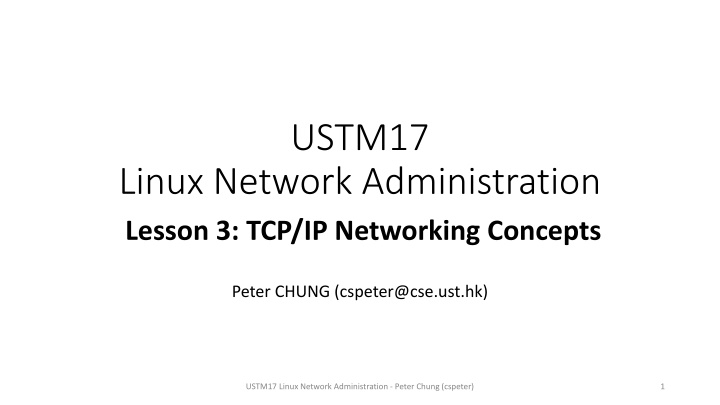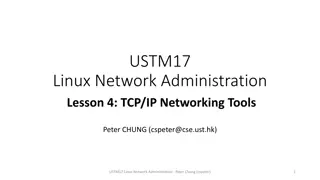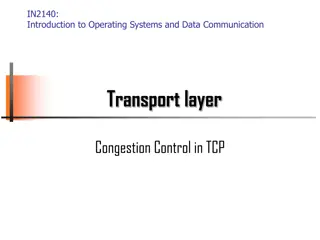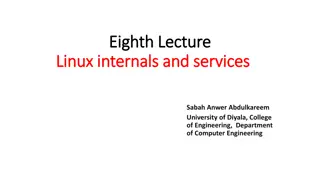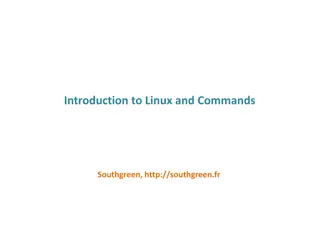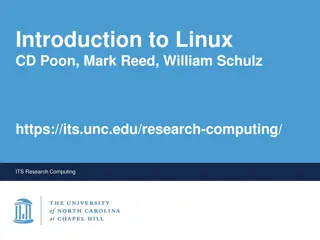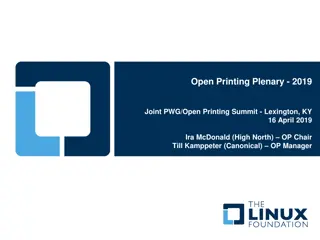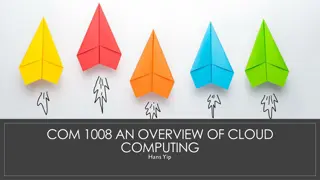TCP/IP Networking Concepts and Predictable Interface Names in Linux
Define and explore TCP/IP networking concepts and predictable network interface names in Linux. Learn about abstract interfaces, hardware access, and naming schemes. Discover the benefits of predictable network interface names in CentOS 8 and familiarize yourself with Ethernet and wireless LAN interfaces.
Download Presentation

Please find below an Image/Link to download the presentation.
The content on the website is provided AS IS for your information and personal use only. It may not be sold, licensed, or shared on other websites without obtaining consent from the author.If you encounter any issues during the download, it is possible that the publisher has removed the file from their server.
You are allowed to download the files provided on this website for personal or commercial use, subject to the condition that they are used lawfully. All files are the property of their respective owners.
The content on the website is provided AS IS for your information and personal use only. It may not be sold, licensed, or shared on other websites without obtaining consent from the author.
E N D
Presentation Transcript
USTM17 Linux Network Administration Lesson 3: TCP/IP Networking Concepts Peter CHUNG (cspeter@cse.ust.hk) USTM17 Linux Network Administration - Peter Chung (cspeter) 1
Network Interfaces in Linux To hide the diversity of hardware components TCP/IP defines an abstract interface through which the hardware is accessed This interface offers a set of operations that is the same for all types of hardware Example: you can ping another machine no matter you are using wired or wireless connection with different hardware configurations USTM17 Linux Network Administration - Peter Chung (cspeter) 2
Predictable Network Interface Names should be used in CentOS 8 (See next slide) The Classic Naming Scheme It is still widely used, but not in some latest Linux distributions (e.g. CentOS 8) The Classic Naming Scheme for Network Interfaces lo refers to the loop back interface (still in use) Classic Naming Scheme for Ethernet eth0, eth1 eth0 refers to the first Ethernet interface If you have installed more than one NIC card, you may have eth1, eth2 USTM17 Linux Network Administration - Peter Chung (cspeter) 3
Predictable Network Interface Names The names have two-character prefixes based on the type of interface: 1. en for Ethernet, 2. wl for wireless LAN (WLAN), 3. ww for wireless wide area network (WWAN). The names have the following types: o<index> On-board device index number s<slot>[f<function>][d<dev_id>] Hotplug slot index number x<MAC> MAC address [P<domain>]p<bus>s<slot>[f<function>][d<dev_id>] PCI geographical location [P<domain>]p<bus>s<slot>[f<function>][u<port>][..][c<config>][i<interface>] USB port number chain Details: https://access.redhat.com/documentation/en-us/red_hat_enterprise_linux/7/html/networking_guide/sec- understanding_the_predictable_network_interface_device_names USTM17 Linux Network Administration - Peter Chung (cspeter) 4
Demo Predictable Network Interface Names ip command will be introduced in great details in the next lesson Please don t copy the result to the workbook exercise Our lab machines may have different configurations Example after running a command ip link lo refers to the loop back interface (using the classic naming scheme) enp0s3 refers to the Ethernet interface (using predictable network interface names) p0 means bus number 0, s3 means slot index 3 (see previous slide) 1: lo: <LOOPBACK,UP,LOWER_UP> mtu 65536 qdisc noqueue state UNKNOWN mode DEFAULT group default qlen 1000 link/loopback 00:00:00:00:00:00 brd 00:00:00:00:00:00 2: enp0s3: <BROADCAST,MULTICAST,UP,LOWER_UP> mtu 1500 qdisc fq_codel state UP mode DEFAULT group default qlen 1000 link/ether 08:00:27:cd:61:5d brd ff:ff:ff:ff:ff:ff USTM17 Linux Network Administration - Peter Chung (cspeter) 5
Demo Domain Names Domain Names IP addresses are hard to memorize Usually, a domain name is required to bind with an IP address www.cse.ust.hk => 143.89.40.27 a fixed IP binding for a HKUST network address hkpeterpeter.github.io => 185.199.109.153 The binding may not be a fixed A quick demo by using the ping command USTM17 Linux Network Administration - Peter Chung (cspeter) 6
Domain Name Registration Companies that offered domain name registration: Hong Kong Domain Name Registration: https://www.hkdnr.hk GoDaddy.com Many other commercial alternatives Free sub-domain name registration no-ip.com and some free webhosting companies You can even use GitHub pages to host your static website for FREE Example: https://hkpeterpeter.github.io/ USTM17 Linux Network Administration - Peter Chung (cspeter) 7
The IP Addressing Scheme (ipv4) The IP addressing scheme for IPv4 Each host is assigned a unique 32-bit number within the same network This address is known as the host s IP address (www.cse.ust.hk) => (143.89.40.27) (www.ee.ust.hk) => (143.89.44.246) (www.ust.hk) => (143.89.14.34) What is your observation based on these examples? USTM17 Linux Network Administration - Peter Chung (cspeter) 8
The IP address Hierarchy IP address is divided into two parts A prefix part Identifies the physical network Each network is assigned a unique network number A suffix part Identifies a computer on the network Inside the same network, the prefix parts are the SAME, only the suffix parts are different USTM17 Linux Network Administration - Peter Chung (cspeter) 9
Properties of IP addressing scheme Each computer in the Internet is assigned a unique address A single address is never assigned to more than one computer in the Internet It is important, if two computers can assign the same IP address at the same time, it may cause some troubles Prefix and suffix of IP addresses Network number (i.e. prefix) assignments MUST be coordinated globally Suffixes can be assigned locally by local network administrators USTM17 Linux Network Administration - Peter Chung (cspeter) 10
Bits on prefix and suffix The prefix needs sufficient bits to allow unique network number to be assigned to each physical network Suppose the first 16 bits are used as prefix and the remaining 16 bits are used as suffix for all IP addresses in the world, what happen? We only support 216 = 65536 companies in the world Not enough for our daily lives Each organization will have at most 65536 computers Too many for a small company USTM17 Linux Network Administration - Peter Chung (cspeter) 11
Method 1: Classful IP addressing We separate all IP addresses into 5 different classes (Class A, B, C, D, E) The first four bits of an IP address determined the class USTM17 Linux Network Administration - Peter Chung (cspeter) 12
Class A, B and C Facts: 27 = 128, 224 = 16777216, 214 = 16384, 216 = 65536, 221 = 2097152, 28 = 256, USTM17 Linux Network Administration - Peter Chung (cspeter) 13
Examples of classful IP addressing IP address: 127.0.0.1 Binary pattern of 127 = 0100 0000 The first bit starts with 0, thus it is a class A IP address USTM17 Linux Network Administration - Peter Chung (cspeter) 14
Examples of classful IP addressing IP address: 143.89.14.7 Binary pattern of 143 = 1000 1111 The first two bits start with 10 , thus it is a class B IP address USTM17 Linux Network Administration - Peter Chung (cspeter) 15
Examples of classful IP addressing IP address: 192.168.1.1 Binary pattern of 192 = 1100 0000 The first three bits start with 100 , thus it is a class C IP address USTM17 Linux Network Administration - Peter Chung (cspeter) 16
Special IP addresses IPv4 defines a set of special address forms that are reserved for special purposes List of special IP addresses Network address Broadcast address Loopback address Private network addresses USTM17 Linux Network Administration - Peter Chung (cspeter) 17
Network address and broadcast address Network address Fill all bits in the host part as 0 For example, 192.168.1.0 represents a class C network address Broadcast address Fill all bits in the host part as 1 For example, 192.168.1.255 represents a class C broadcast address USTM17 Linux Network Administration - Peter Chung (cspeter) 18
Demo How to use broadcasting? Enable broadcasting Many modern OS are now disabling response to the broadcasting by default Modify this file /proc/sys/net/ipv4/icmp_echo_ignore_broadcasts Change the value from 1 to 0 Use ping command to ping the broadcast address, for example ping -b [the broadcast address] You can use the ip address command to find out the broadcast IP address ip command will be introduced in great details in the next lesson USTM17 Linux Network Administration - Peter Chung (cspeter) 19
Demo Using loopback address (127.0.0.1) Demo: ping 127.0.0.1 Example of using a loopback address in a client/server model A server program is running on a computer using a loopback address A client program is running on the same computer and send data to the loop back address Data travels down the protocol stack (from top to bottom) from the client program Data travels up through the protocol stack (from bottom to top) to the server program All things happen in the same computer, without any physical network involved in the process USTM17 Linux Network Administration - Peter Chung (cspeter) 20
Ranges of the private network addresses USTM17 Linux Network Administration - Peter Chung (cspeter) 21
Problem of Classful IP addressing Insufficient IP addresses are available if the original classful IP addressing is adopted Large organizations may not be able to get as many IP addresses in the Internet as they need Example: UPS (a large company enables users to track the delivery record ) needs IP addresses for millions of its computers Some organizations do not use all their assigned IP addresses (waste a range of IP addresses) Example: SUNY Stony Brook (a US university) has a Class B IP addresses with 65,356 IP addresses available, but only uses 3000-5000 addresses USTM17 Linux Network Administration - Peter Chung (cspeter) 22
Classless Addressing Subnet mask is used to divide an IP address at an arbitrary boundary A subnet mask for IPv4 A 32-bit value starting with 1 s and ends with 0 s Bit pattern such as 11001000 11110000 00000000 11110101 is NOT a valid subnet mask Example: 255.255.255.0 Subnet mask is NOT limited to byte boundary! Example: 255.255.255.192 may also be a subnet mask USTM17 Linux Network Administration - Peter Chung (cspeter) 23
Motivation of subnet mask A subnet mask is an efficient way to compute the boundary between the prefix part and the suffix part How to compute the prefix part and the suffix part if classless addressing is adopted? Using a logical AND bitwise operation Example: Given the HKUST web server s IP address (www.ust.hk) as (143.89.14.34) What is the prefix part and the suffix part if the subnet mask 255.255.0.0 is adopted? USTM17 Linux Network Administration - Peter Chung (cspeter) 24
Computation of the prefix/suffix of classless addressing (Ex. 1) Given the HKUST web server s IP address (www.ust.hk) as (143.89.14.34) What is the prefix part and the suffix part if the subnet mask 255.255.0.0 is adopted? Binary pattern of 143.89.14.34 10001111 01011001 00001110 00100010 Binary pattern of 255.255.0.0 11111111 11111111 00000000 00000000 Result: Prefix: 10001111 01011001 (16 bits) Suffix: 00001110 00100010 (16 bits) Number of possible hosts in this network ~2^16 USTM17 Linux Network Administration - Peter Chung (cspeter) 25
Computation of the prefix/suffix of classless addressing (Ex. 2) Given the HKUST web server s IP address (www.ust.hk) as (143.89.14.34) What is the prefix part and the suffix part if the subnet mask 255.255.128.0 is adopted? Binary pattern of 143.89.14.34 10001111 01011001 00001110 00100010 Binary pattern of 255.255.128.0 11111111 11111111 10000000 00000000 Result: Prefix: 10001111 010110010 (17 bits) Suffix: 0001110 00100010 (15 bits) Number of hosts in this network ~2^15 USTM17 Linux Network Administration - Peter Chung (cspeter) 26
Computation of the prefix/suffix of classless addressing (Ex. 3) Given the HKUST web server s IP address (www.ust.hk) as (143.89.14.34) What is the prefix part and the suffix part if the subnet mask 255.255.192.0 is adopted? Binary pattern of 143.89.14.34 10001111 01011001 00001110 00100010 Binary pattern of 255.255.192.0 11111111 11111111 11000000 00000000 Result: Prefix: 10001111 0101100100 (18 bits) Suffix: 001110 00100010 (14 bits) Number of hosts in this network ~2^14 USTM17 Linux Network Administration - Peter Chung (cspeter) 27
Computation of the prefix/suffix of classless addressing (Ex. 4) Given the HKUST web server s IP address (www.ust.hk) as (143.89.14.34) What is the prefix part and the suffix part if the subnet mask 255.255.255.0 is adopted? Binary pattern of 143.89.14.34 10001111 01011001 00001110 00100010 Binary pattern of 255.255.255.0 11111111 11111111 11111111 00000000 Result: Prefix: 10001111 01011001 00001110 (24 bits) Suffix: 00100010 (8 bits) Number of possible hosts in this network ~2^8 USTM17 Linux Network Administration - Peter Chung (cspeter) 28
Sub Networks (subnets) It allows a network administrator to subdivide a large network into a number of smaller subnets Example: 143.89.0.0 is a class B network Default netmask is 255.255.0.0 Suppose I would like to apply a subnet mask of 255.255.255.0 on this class B network It is decomposed into 254 (Why it is equal to 254?) subnets 143.89.1.0 to 143.89.254.0 USTM17 Linux Network Administration - Peter Chung (cspeter) 29
Notation: Network + Netmask Sometimes, it is hard to read a netmask (e.g. 255.255.255.0) We can shorten the notation as follows: 192.168.5.0/24 It means a network (192.16.5.0) with a netmask (255.255.255.0) because there are 24 bit of 1s followed by 8 bits of 0s Example 192.168.5.0/24 can be further broken down to 4 subnets: 192.168.5.0/26 192.168.5.64/26 192.168.5.128/26 192.168.5.192/26 Subnet mask: 255.255.255.192, and the remaining 6 bits for the host identifier USTM17 Linux Network Administration - Peter Chung (cspeter) 30
Reasons for making subnets An internal division of network In HKUST, if a subnet mask 255.255.255.0 is applied (cse.ust.hk) => (143.89.40.0) (ee.ust.hk) => (143.89.44.0) (ust.hk) => (143.89.14.0) It supports at most 254 departments, each department has 254 IP addresses USTM17 Linux Network Administration - Peter Chung (cspeter) 31
Criteria of Creating Subnets Subnets are maintained by the network administrators based on the following criteria Physical (between two Ethernets) Administrative (between two departments) Geographical (between two locations) USTM17 Linux Network Administration - Peter Chung (cspeter) 32
Gateways Hosts on a given physical network can only talk to other hosts within the network The usage of gateways All other hosts can be accessed only through special-purpose machines called gateways A gateway is a host that is connected to two or more physical networks simultaneously and is configured to switch packets between them We can use ip command to find a gateway computer Details will be covered in the next lesson USTM17 Linux Network Administration - Peter Chung (cspeter) 33
Any questions so far? USTM17 Linux Network Administration - Peter Chung (cspeter) 34
